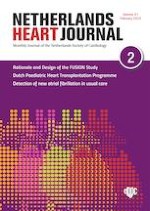Introduction
The diagnostic accuracy of cardiovascular physical examination
Physical signs of severe valvular heart disease | LR and change in pre-test probability |
|---|---|
Aortic stenosis | |
Delayed upstroke carotid pulse | LR + 6.8 (+35–40%) |
Diminished or absent S2 | LR + 7.5 (+35–40%) |
Carotid radiation | LR + 8.1 (+40%) |
Systolic murmur with broad apical-base pattern (see Fig. 1) | LR + 9.7 (+45%) |
Mitral regurgitation | |
Systolic murmur with broad apical pattern (see Fig. 1) | LR + 6.8 (+35–40%) |
Systolic murmur with loud S2 | LR + 4.7 (+30%) |
The diagnostic accuracy of handheld echocardiography
Type of device | Company | Weight | Displaya | 2D Doppler | MHz | Colour Doppler | CW or PW Doppler | Estimated price |
|---|---|---|---|---|---|---|---|---|
Vscan | GE Healthcare | 450 g | Yes | Yes | 3–8 | Yes | No | 5300 € |
Acuson P10 | Siemens | 700 g | Yes | Yes | 2–4 | No | No | 3600 € |
PA HD | Clarius | 350 g | No | Yes | 1–4 | Yes | Yes | 4400 € |
Lumify S4‑1 | Philips | 150 g | No | Yes | 1–4 | Yes | No | 6500 € |
iQ | Butterfly | 300 g | No | Yes | Yes | No | 1899 € |
Relevant target with handheld echocardiography | Parameter |
|---|---|
Left ventricular systolic function and dimensions | Visual estimation of left ventricular ejection fraction, possibility of post-processing of images to calculate ejection fraction |
Right ventricular systolic function and dimensions | Visual estimation of right ventricular function and dimensions |
Left and right atrial sizes | Left atrial diameter |
Valvular heart disease | Morphological valvular abnormalities |
Large intracardiac masses | |
Pleura and lung parenchyma | B‑lines in pulmonary congestion Pleural effusion |
Intravascular volume assessment and screening for aortic aneurysm | Intravascular volume assessment (inferior vena cava diameter), diameter of thoracic and abdominal vessels |
Pericardial effusion/tamponade | Amount of pericardial effusion |
